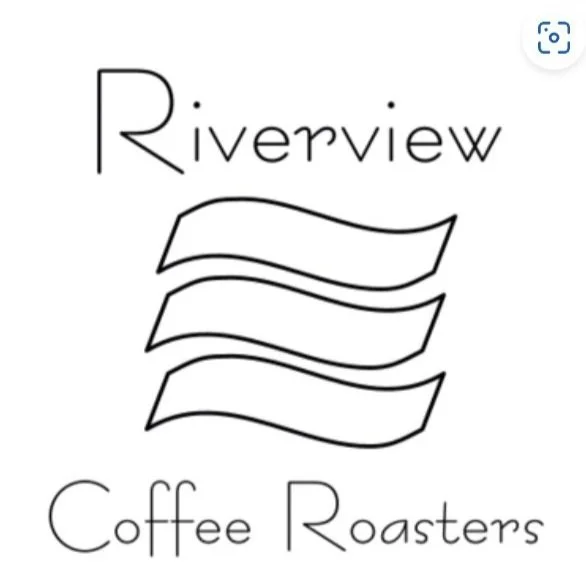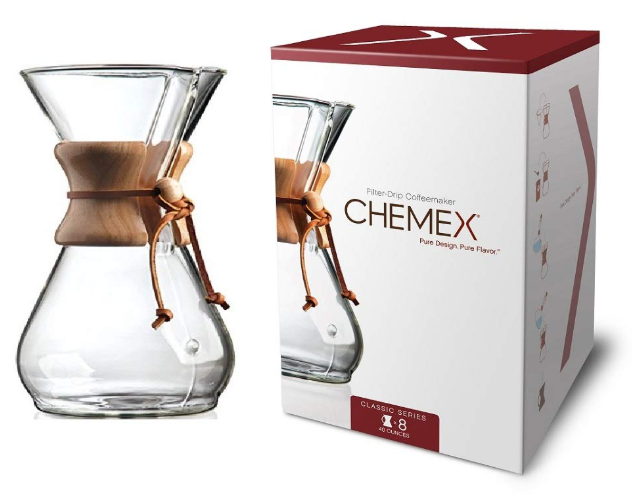Chemex
Made of non-porous Borosilicate glass which will not absorb odors or chemical residues
CHEMEX pour-over allows coffee to be covered and refrigerated for reheating without losing flavor
Simple, easy to use with timeless, elegant design
Use CHEMEX Bonded Filters FP-1, FC-100, FS-100, FSU-100
Invented by a chemist to improve filter brewing, Chemex has a devoted following of folks. The cornerstone of this method is Chemex’s branded filter; they are 20-30% heavier than any other filter and have a special paper formulation to remove sediment but allow positive aromatic compounds to pass through.
The fine paper grain holds back "mud," while permitting correct filtration speed. Chemex brews at least 1-2 minutes slower than normal paper filters, more in line with the optimal time that hot water and grinds should contact each other: 4 minutes. The Chemex filter paper is heavy, so pre-rinsing is essential.
The Chemex is all glass, which makes it very easy to clean. Maybe the best thing about the Chemex is that you can see the process, interact, and make changes. There's a lot to be said for that and we shouldn't dismiss it.
Everyone has their own pouring technique (let the coffee pre-infuse/bloom or not, pre-wet the filter, pour at a particular rate) and the results are there in the cup. Machines don't typically allow for this.
Want to impress your friends? Tell them that your Chemex is in the permanent collection of the Museum of Modern Art in New York.
The are a few key advantages to using a Chemex Brewer and making manual, pour-over drip coffee rather than auto-drip brewing with a home machine. The first key point is that the coffee-water mixture is the right temperature (between 195-205 f) from the beginning of the infusion. Few auto drip makers are capable of this. Over time, even a good auto-drip maker will brew at lower and lower temperatures - especially if it is not kept clean. Secondly, you gain some control over infusion time based upon the fineness of your grind, and pouring technique. Lastly, is that you can keep this simple brew system very clean: auto-drip makers become foul with rancid coffee residue, and invariably even with drip machines that are diligently cleaned, one can immediately taste this bitter, off flavor.
A disadvantage of paper filters is they can impart a noticeable flavor to the brew, especially the thick Chemex filters. So pre-wetting the filter is key to excellent Chemex brewing. Also, Chemex brewing is best when brewing larger amounts of coffee: paper taste and heat loss are more noticeable when trying to brew a small batch of say 12 oz.
Chemex Brewing
1. Open the Chemex-Bonded Coffee Filter into a cone. One side should have 3 layers, the other side 1 layer. Place the cone in the top of your coffeemaker with the thick portion toward the pouring spout. You may use non-Chemex filters like the Filtropa brand in #4 or #6 cone size, but Chemex filters are specifically designed to perform with the brewer. Using hot water, pour in about 2 oz. so it wets the paper filter. The Chemex filter sticks to the glass sufficiently so you can invert it over the sink and the water will drain back out without taking the filter with it.
2. Using a medium* grind for regular paper filter brewing, put one coffee measure (7.25 grams by weight) of coffee per 6 oz cup into the filtercone. Chemex instructions state one rounded tablespoon per 5 oz cup: standard SCAA brewing is 7.25 grams per 6 oz cup.
On the proper grind: If the water stalls completely in the grounds - your grind is too fine. If it pours through too fast, and the resulting coffee is weak - then the grind is too coarse. Adjust to your preference!
3. When the water is boiling, remove it from the heat for 30 seconds. It should now be about 195 to 205 degrees F., the perfect brewing temperature. Chemex recommends pouring a small amount of water over the grinds, just enough to wet them without floating them. This pre-wetting allows coffee to "bloom", to swell and prepare for even infusion brewing.
4. After this first wetting simply pour more water, soaking the grounds each time but keeping the water level well below the top of the coffeemaker. Pour slowly in a circular motion, being sure to keep coffee in as compact an area as possible. Don't let the grinds go dry during the brew process or you have lost that good 195 - 205 brew temperature. Don't pass too much water through the grounds or you will have weak coffee with over-infused bitter components in it. Once the desired amount of coffee is brewed, dispose of the spent grounds by lifting the filter out of the coffeemaker (great for the compost or vermiculture!).
"The key to the Chemex method is the fractional extraction of only the desirable parts of the coffee bean. Chemex-Bonded filters make this possible. They are 20 to 30 percent heavier than other filters, and filter out all sediment. They have been specifically designed to give balanced performance with the Chemex Coffeemaker. The filter combines a very fine grain, required for holding back the coffee mud, with the right filtration speed (not too slow, not too fast) that promotes proper infusion. ... The filter is designed not to burst under the weight of the liquid during infusion, and not to break when lifting out the grinds. No other coffee filter is made to the Chemex specifications." -Chemex Company Literature





